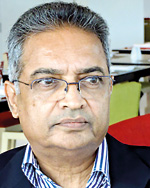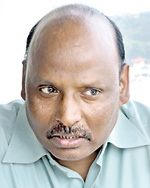Sustainable development through education
Dr. Ram Boojh and Dr. Mitrasen Bhikajee, programme specialists from the UNESCO in New Delhi were in Sri Lanka recently to attend the World Environment Day Commemoration on June 5 organised by the National Institute of Education in Maharagama.

Dr. Mitrasen Bhikajee
Themed as ‘7 billion dreams. One planet. Consume With Care’ this year’s World Environment Day celebrations focused on current consumption patterns steering natural resources to irreversible tipping points. According to the Worldwatch Institute, calculations reveal that the planet has 1.9 hectares of land per person available to supply our resources and absorb our waste. Consumption patterns vary across the globe, however, with the average American using 9.7 hectares worth of land for their needs in stark contrast to the average Mozambican who uses 0.47 hectares. Regardless of country specifics the impact of such consumption will be felt across the globe.
The most important action to be taken at this juncture is education about sustainable development, emphasised Dr. Boojh. “We still find a great lack of awareness amongst most communities about the impact their consumption has on the environment,” he noted. “We have passed the 400 ppm (the amount of carbon dioxide in the atmosphere in parts per million) limit already.” Stabilisation of the levels of carbon dioxide released into the atmosphere is imperative to slow its growth, he noted.

Dr. Ram Boojh
Carbon dioxide (CO2) is the primary driver of recent climate change. Figures released by US science agency NOAA (National Oceanic and Atmospheric Administration) in early May this year show that for the first time since records began, the parts per million (ppm) of CO2 in the atmosphere were over 400 ppm globally per month.
With the Millennium Development Goals expiring this year, the UN has identified 17 Sustainable Development Goals (SDGs). The SDGs are a new, universal set of goals, targets and indicators that UN member states will be expected to use to frame their agendas and political policies over the next 15 years. “It’s time for countries to make more commitments,” said Dr. Bhikajee. “We must carry forward the unfinished agenda from the last decade to ensure that these new goals are adopted by every country in the world.”
This is why education is perhaps the most important aspect of this new development agenda, they note. “The quality of such education and access to it is very important,” Dr. Boojh emphasised. “Global citizenship is vital because we need to realise that our consumption habits can affect people living a thousand miles away.”
The challenge is in identifying new ways to sensitise people, shared Dr. Bhikajee. Traditionally workshops and forums were used to communicate with audiences but now organisations such as UNESCO use apps, games and social media more to engage with a younger and much more technologically driven audience, they shared.
Dr. Boojh and Dr. Bhikajee also cited examples of activities that could be conducted at the classroom level for awareness. Children tend to be very visual and a bottle filled with water could be used to demonstrate the world’s water resources, of which only 2-3 % is fresh water. “Simple demonstrations like this in class, instead of textbook explanations, will go a long way to get children interested and more aware of the impact they will have as adults on the environment,” said Dr. Boojh.


